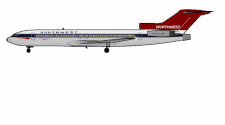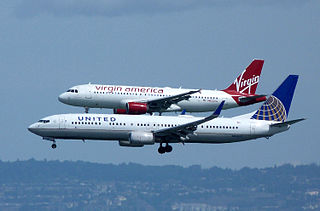
An airliner is a type of airplane for transporting passengers and air cargo. Such aircraft are most often operated by airlines. The modern and most common variant of the airliner is a long, tube shaped, and jet powered aircraft. The largest of them are wide-body jets which are also called twin-aisle because they generally have two separate aisles running from the front to the back of the passenger cabin. These are usually used for long-haul flights between airline hubs and major cities. A smaller, more common class of airliners is the narrow-body or single-aisle. These are generally used for short to medium-distance flights with fewer passengers than their wide-body counterparts.

The Boeing 727 is an American narrow-body airliner that was developed and produced by Boeing Commercial Airplanes. After the heavier 707 quad-jet was introduced in 1958, Boeing addressed the demand for shorter flight lengths from smaller airports. On December 5, 1960, the 727 was launched with 40 orders each from United Airlines and Eastern Air Lines. The first 727-100 rolled out on November 27, 1962, first flew on February 9, 1963, and entered service with Eastern on February 1, 1964.

The Lockheed L-1011 TriStar is an American medium-to-long-range, wide-body trijet airliner built by the Lockheed Corporation. It was the third wide-body airliner to enter commercial operations, after the Boeing 747 and the McDonnell Douglas DC-10. The airliner has a seating capacity of up to 400 passengers and a range of over 4,000 nautical miles. Its trijet configuration has three Rolls-Royce RB211 engines with one engine under each wing, along with a third engine center-mounted with an S-duct air inlet embedded in the tail and the upper fuselage. The aircraft has an autoland capability, an automated descent control system, and available lower deck galley and lounge facilities.

The McDonnell Douglas DC-10 is an American trijet wide-body aircraft manufactured by McDonnell Douglas. The DC-10 was intended to succeed the DC-8 for long-range flights. It first flew on August 29, 1970; it was introduced on August 5, 1971, by American Airlines.
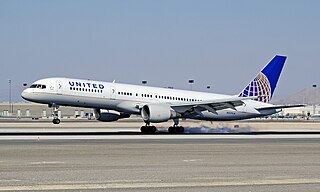
The Boeing 757 is an American narrow-body airliner designed and built by Boeing Commercial Airplanes. The then-named 7N7, a twinjet successor for the trijet 727, received its first orders in August 1978. The prototype completed its maiden flight on February 19, 1982, and it was FAA certified on December 21, 1982. Eastern Air Lines placed the initial 757-200 variant in commercial service on January 1, 1983. A package freighter (PF) variant entered service in September 1987 and a combi model in September 1988. The stretched 757-300 was launched in September 1996 and began service in March 1999. After 1,050 had been built for 54 customers, production ended in October 2004, while Boeing offered the largest 737 NG variants as a successor to the -200.

A wide-body aircraft, also known as a twin-aisle aircraft and in the largest cases as a jumbo jet, is an airliner with a fuselage wide enough to accommodate two passenger aisles with seven or more seats abreast. The typical fuselage diameter is 5 to 6 m. In the typical wide-body economy cabin, passengers are seated seven to ten abreast, allowing a total capacity of 200 to 850 passengers. Seven-abreast aircraft typically seat 160 to 260 passengers, eight-abreast 250 to 380, nine- and ten-abreast 350 to 480. The largest wide-body aircraft are over 6 m (20 ft) wide, and can accommodate up to eleven passengers abreast in high-density configurations.
This is a list of aviation-related events from 1980.
This is a list of aviation-related events from 1983.

The Yakovlev Yak-42 is a 100/120-seat three-engined mid-range passenger jet developed in the mid 1970s to replace the technically obsolete Tupolev Tu-134. It was the first airliner produced in the Soviet Union to be powered by modern high-bypass turbofan engines.
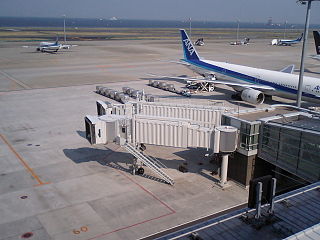
A jet bridge is an enclosed, movable connector which most commonly extends from an airport terminal gate to an airplane, and in some instances from a port to a boat or ship, allowing passengers to board and disembark without heading outside and being exposed to harsh weather. Depending on building design, sill heights, fueling positions, and operational requirements, a jet bridge may be fixed or movable, swinging radially, and/or extending in length. The jetway was invented by Frank Der Yuen.

Combi aircraft in commercial aviation are aircraft that can be used to carry either passengers as an airliner, or cargo as a freighter, and may have a partition in the aircraft cabin to allow both uses at the same time in a mixed passenger/freight combination. The name combi comes from the word combination. The concept originated in railroading with the combine car, a passenger car that contains a separate compartment for mail or baggage.

A cargo aircraft is a fixed-wing aircraft that is designed or converted for the carriage of cargo rather than passengers. Such aircraft generally feature one or more large doors for loading cargo. Passenger amenities are removed or not installed, although there are usually basic comfort facilities for the crew such as a galley, lavatory, and bunks in larger planes. Freighters may be operated by civil passenger or cargo airlines, by private individuals, or by government agencies of individual countries such as the armed forces.

The McDonnell Douglas DC-9 is an American five-abreast, single-aisle aircraft designed by the Douglas Aircraft Company. It was initially produced as the Douglas DC-9 prior to August 1967, after which point the company had merged with McDonnell Aircraft to become McDonnell Douglas. Following the introduction of its first jetliner, the high-capacity DC-8, in 1959, Douglas was interested in producing an aircraft suited to smaller routes. As early as 1958, design studies were conducted; approval for the DC-9, a smaller all-new jetliner, came on April 8, 1963. The DC-9-10 first flew on February 25, 1965, and gained its type certificate on November 23, to enter service with Delta Air Lines on December 8.
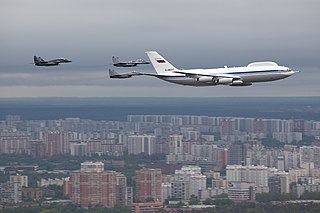
The Ilyushin Il-80 is a Russian airborne command and control aircraft modified from the Ilyushin Il-86 airliner.

A trijet is a jet aircraft powered by three jet engines. In general, passenger airline trijets are considered to be second-generation jet airliners, due to their innovative engine locations, in addition to the advancement of turbofan technology. Trijets are more efficient than quadjets, but not as efficient as twinjets, which replaced trijets as larger and more reliable turbofan engines became available.
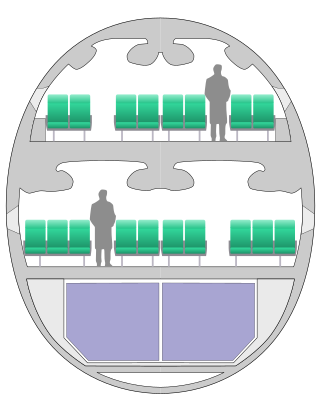
A double-deck aircraft has two decks for passengers; the second deck may be only a partial deck, and may be above or below the main deck. Most commercial aircraft have one passenger deck and one cargo deck for luggage and ULD containers, but a few have two decks for passengers, typically above or below a third deck for cargo.

An S-duct is a type of jet engine intake duct used in several types of trijet aircraft. In this configuration, the intake is in the upper rear center of the aircraft, above or below the stabilizer, while the exhaust and engine is at the rear of the aircraft. The S-duct is located in the tail, or empennage, of the aircraft. The shape of the S-duct is distinctive and easily recognized, and was used in several aircraft, beginning in 1962 with the Hawker Siddeley Trident. Currently, the Dassault Falcon 8X and Dassault Falcon 900 business jets are the only aircraft in production that use the S-duct design.
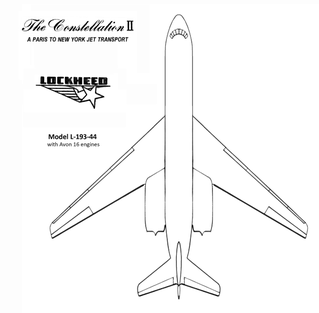
The Lockheed L-193 Constellation II was a jet airliner design concept, designed between 1949 and 1953 with a swept wing and engines mounted at the tail. An airliner and tanker version were developed. The latter, in an aerial refueling competition initiated by the United States Air Force (USAF), won and was preferred over the Boeing KC-135 Stratotanker. Since the competing Boeing aircraft was ready to fly first, examples were ordered as an interim measure. They performed well enough that the L-193 was never ordered as a tanker, and airliner plans were dropped soon after.





